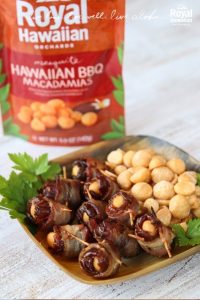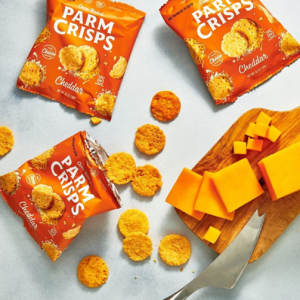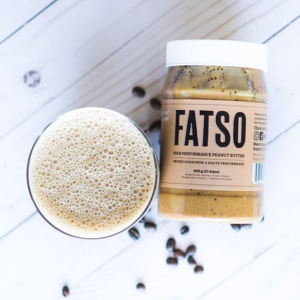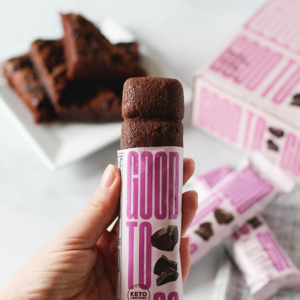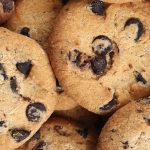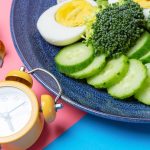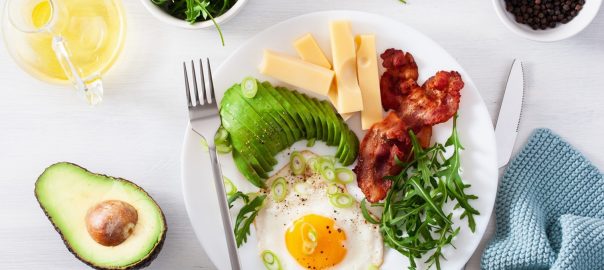
Keto Diets & Fat Consumption
How to Get Enough Fat on Keto
Learn how to meet low carb, moderate protein, high fat macronutrient ratios required for a ketogenic diet with tips, recipes, and more in this article.
Consuming 70-80% of your daily calories from fat might seem like a bit of a challenge, especially if you’re used to eating meals higher in protein or carbohydrates. You might be wondering what some of your meals will look like on a ketogenic diet, so we are here to guide you! Keep reading to learn our tips for how to get enough fat on a ketogenic diet and discover low carb high fat recipes and products available on our website.
Disclaimer: The information in this article is not intended to replace personalized medical advice. A low carb diet may not be suitable for you. Consult your health care provider before making any changes to your lifestyle or use this information at your own risk.
How Much Fat Should You Eat on a Ketogenic Diet?
For starters, you might be wondering exactly how much fat you have to eat on a ketogenic diet. Typically, to get into the fat-burning metabolic state known as ketosis, your body requires the following dietary macronutrient ratios:
- 70%+ of daily calories from fat
- 20-25% of daily calories from protein
- 10% or less of daily calories from carbohydrates
How to Keep Track of Macronutrients
It’s not obvious which calories are from fat, protein, and carbohydrates when you’re reading nutrition labels. So, it can seem confusing at first how to track your macros on a keto diet. It’s helpful to understand how many calories are in 1g of each macronutrient. Then, you can calculate how many grams you should eat of each macronutrient per day.
Here are the calorie contents per gram of fat, protein, and carbohydrates:
1 gram of fat = 9 calories
1 gram of protein = 4 calories
1 gram of carbohydrates = 4 calories
Next, you will need to determine how many calories you eat or intend to eat in a day. Check out our article about how our bodies burn calories and speak to your health care practitioner to determine your individual caloric sweet spot.
For the sake of example, if you consume 2000 calories a day, you should aim for the following amounts of fat, protein, and carbohydrates on a ketogenic diet:
Fat: 70% x 2000 calories/day = 1400 calories ÷ 9 calories/gram = 155g
Protein: 20% x 2000 calories/day = 400 calories ÷ 4 calories/gram = 100g
Carbohydrates: 10% x 2000 calories/day = 200 calories ÷ 4 calories/gram = 50g*
Nutrition labels will display how many grams of fat, protein, and carbohydrates are contained in the food you are eating. It can also be helpful to have a kitchen scale on hand to help measure things like fruit, vegetables, and other unpackaged items. Diet apps or a simple web search will also be able to tell you how many grams of each macronutrient are typically found in things like produce and meat. Most low carb and keto dieters find it helpful to keep a journal or note on their phone to track their macros throughout the day. Once you become more familiar with the macronutrient ratios of foods and meals you eat regularly, this may become less necessary.
*This is how many total carbohydrates you should consume per day. However, the amount of net carbs you will consume will vary depending on the fibre content of the foods you eat. Net carbs are calculated by taking the total carbohydrates in a given food and subtracting the fibre content plus any sugar alcohols. What you are left with is the sugar and starch content, which is really what we’re trying to limit on a ketogenic diet since neither fibre nor sugar alcohols affect blood sugar levels or the body’s ability to get into ketosis.
Tips for Getting Enough Fat on Keto
- Cook with healthy fats.
We often overlook the kind of oil we splash into the pan before cooking a meal. However, cooking oils are a great opportunity to help us get more healthy fats into our diet, with the right choices.
There is a wide range of options when it comes to cooking oils, and there are different circumstances in which they are ideally used. For starters, there are a few cooking oils that should be avoided altogether. From a health perspective, certain oils release inflammatory compounds when heated at high temperatures. These oils include:
- Refined or hydrogenated canola oil, AKA “rapeseed oil”
- Corn oil
- Soybean oil
- Margarine and vegan butter substitutes made from vegetable/palm oils
- Grapeseed oil
Note that these oils, especially hydrogenated vegetable oils, are commonly used in the fryers at fast food restaurants. Not only does frying foods with these oils at high temperatures raise health concerns, but the oil is also changed very infrequently, causing a further buildup of toxins after cooking several batches. Therefore, it is best to avoid fried and fast foods since regular consumption of these oils can increase your risk for cardiovascular disease, diabetes, and obesity.
Oils that are best used for drizzling over meals, making salad dressings or other out-of-the-skillet applications include:
- Flaxseed oil
- Hemp seed oil
- Sunflower oil
- Most nut oils such as walnut oil and peanut oil
- Sesame seed oil
- Extra virgin olive oil (can also be used in low to medium heat cooking)
Finally, the best oils for high heat cooking are:
- Unrefined (virgin) coconut oil (350˚F smoke point)
- Avocado oil (520˚F smoke point)
- Macadamia nut oil (410˚F smoke point)
- Grass-fed butter (350˚F smoke point)
- Ghee, AKA clarified butter (485˚F smoke point)
For more tips on how to choose the best cooking oils, check out our blog post on this topic!
- Garnish your meals with a fat source.
Opportunities to add more fat to your meals don’t end once you’re done cooking! Here are some high fat garnishes you can add to your meals:
- Chia seeds
- Hemp hearts
- Sunflower seeds
- Pumpkin seeds
- Crushed nuts (keep reading to learn what the lowest carb nuts are!)
- Unsweetened coconut chips or shredded coconut
- Crumbled goat’s cheese or feta cheese (or other soft cheese)
- Shaved parmesan (or other hard cheese)
- Skip low fat and fat-free products.
On a diet that requires a high fat intake, there is simply no need for reduced fat foods! Low fat yogurt and skim (1%) milk are some common examples of foods you should be buying in full-fat versions. Other foods labeled as “light” or “lite” indicate that the food contains 50% less fat than regular versions and should also be swapped out.
Another reason to avoid reduced fat products is that they tend to contain added sugars to make up for the loss of flavour from a lack of fat. This is exactly the opposite of what we should be consuming on a low carb high fat diet! Read more on how to detect hidden carbs in common foods.
- Finish meals with a drizzle of oil.
A finishing drizzle of oil is a great way to add an extra 10-20g of fat to your meal! As mentioned previously, some great oils for drizzling include extra virgin olive oil and flaxseed oil. Without cooking these oils, all of the original nutrients are preserved so you can get the most out of each drop! Extra virgin olive oil is naturally very high in antioxidant compounds which can be great for suppressing chronic conditions triggered by inflammation, such as arthritis, auto immune diseases including type 1 diabetes, type 2 diabetes, asthma, neurological disorders, and even cancer. Olive oil is also rich in healthy monounsaturated fats, which promote healthy metabolism, lower LDL (“bad”) cholesterol levels, and prevent heart disease.
Flaxseed oil is another great choice because it is one of the richest plant sources of omega-3 fatty acids! It also has an ideal omega-3 to omega-6 ratio of 4:1, which is what we should be aiming for in our overall diets. Unfortunately, due to mass consumption of fast food and processed foods made with low quality fats, most North Americans don’t achieve this ratio. Instead, those who follow a standard Western diet are typically consuming a ratio of 15:1 or higher. Consuming too many omega-6 fatty acids and not enough omega-3 fatty acids causes inflammation in the body, which can lead to the development of chronic diseases such as those mentioned above. Shop Snow Farms Organic Canadian Flaxseed Oil to balance out your ratio!
- Snack high fat.
Snacks are a great way to get more fat in your diet and balance out your other macros throughout the day. Plus, if high fat meals feel like too much to eat in one sitting, or if you share meals with family members who don’t follow a ketogenic diet, snacks are your golden opportunities to get more fat in your diet!
Here are some of our favourite high fat snack options:
Nuts
Nuts are a great source of healthy plant-based fats and are generally low in carbohydrates. They are also a rich source of many essential vitamins and minerals including vitamin E, zinc, and magnesium, as well as antioxidants. The best nuts to snack on for a low carb diet include:
- Pecans (1g net carbs per 28g (1 small handful))
- Brazil nuts (1g net carbs per 28g)
- Macadamia nuts (2g net carbs per 28g)
- Walnuts (2g net carbs per 28g)
- Hazelnuts (2g net carbs per 28g)
- Almonds (3g net carbs per 28g)
- Peanuts (4g net carbs per 28g)
Avoid nuts that are higher in carbohydrates such as pistachios (5g net carbs per 28g), cashews (7g net carbs per 28g), and chestnuts (7.5g net carbs per 28g). If you have a nut allergy, seeds are a great alternative snack choice (learn more about low carb diets and allergy management). Pumpkin seeds and sunflower seeds are both nutritious and relatively low in carbohydrates with 1.5g and 3g net carbs per 28g, respectively. You can also make a delicious healthy pudding by soaking chia seeds, hemp seeds, and ground flaxseeds in coconut milk overnight! Add liquid stevia drops and spices such as cinnamon for a bit of extra sweetness and flavour.
Pictured: Snacks prepared with Royal Hawaiian Orchards BBQ Macadamia Nuts
Cheese
Cheese is naturally high in fat and low in carbohydrates. It also provides a moderate amount of protein, making it a great snack choice for ketogenic diets!
Learn about the best cheeses for low carb and keto diets on our blog. If you’re looking for some crunchy snacks to enjoy your cheese with, check out our selection of low carb and keto-friendly crackers and chips or shelf-stable crunchy cheese snacks!
Pictured: Parm Crisps Oven Baked Cheese Snacks – Cheddar
Fat Bombs
Fat bombs are the quintessential keto snack! There are thousands of recipes out there ranging in complexity from just a few simple ingredients to more elaborate combinations. In general, fat bombs are similar to a raw cookie or truffle made from a combination of high-fat ingredients such as cream cheese, cocoa butter, coconut oil and/or nut and seed butters. They are usually sweetened with a keto-friendly sweetener and flavoured with unsweetened cocoa powder, spices, and/or sea salt. They truly feel like an indulgent snack yet are highly nutritious and beneficial for keto diets!
Shop Keto Wise Fat Bombs on our website if you are looking for a convenient option to keep in your pantry.
High Fat Beverages
Smoothies are a tasty and efficient way to get enough fat on a keto diet. Load up your blender with nut or seed butter, full fat coconut milk, full fat yogurt, avocado and a small handful of low carb fruit such as berries. Since smoothies typically contain more fruit than a keto diet may allow, you can add flavoured zero carb sweeteners in place of high carb fruits such as bananas. Add greens, chia seeds, and flax seeds to your smoothies as well for some extra fibre, or a scoop of protein powder to balance out your macros.
You can also blend a fat source into coffee or hot cocoa. Try bulletproof coffee recipes by blending MCT oil, coconut oil, or even nut butter into your morning cup of joe. If you’re making hot cocoa, be sure to look for sugar-free hot cocoa mix, or combine raw cocoa powder with a sweetener of your choice.
Pictured: Coffee blended with Fatso High Performance Peanut Butter
Keto Snack Bars
If you’re looking for a simple snack that you can enjoy on the go or on busy days, keto snack bars are a great option! The Low Carb Grocery carries a very wide range of keto-friendly snack bars. Browse gluten-free, plant-based, high protein and minimally processed options on our website!
Pictured: Good To Go Keto Snack Bars in Double Chocolate
Low Carb High Fat Meal Ideas
Below are some simple meal ideas if you are still feeling a bit lost about your options on a low carb high fat diet.
Breakfast
- A spread of eggs, avocado, cheese and greens dressed in olive oil, salt and pepper.
- A bowl of full-fat natural or Greek yogurt topped with keto-friendly granola.
- 1-2 slices of toasted keto-friendly bread topped with brie or ricotta cheese and keto blueberry jam.
Lunch
- A Mediterranean-style salad with grilled salmon, avocado, cucumbers, olives, and feta or goat’s cheese with keto Greek dressing.
- A low carb high fat sandwich.
- Omelet with cheese, vegetables, and herbs (dill, basil, oregano, etc.) cooked in olive oil or grass-fed
Dinner
- Keto chicken/tofu curry made with full fat coconut cream.
- Chicken or beef skewers with 5-ingredient keto satay sauce (full fat coconut cream, peanut butter, Thai red curry paste, lime juice and liquid stevia drops) and a green salad.
- Low carb pasta substitute with turkey meatballs finished with generous drizzle of olive oil and parmesan cheese.
- Bean-less chilli served with sour cream, shredded cheese and/or avocado slices.
- Nut-crusted grilled salmon with a low carb rice substitute/cauliflower rice and greens sauteed in olive oil.
Stay Connected
We hope that you feel empowered to tackle a low carb high fat or ketogenic diet after reading this article! If you would like to share your thoughts or experiences with us, head over to our Facebook and Instagram pages.
If you haven’t already, sign up to our free email newsletter for low carb and sugar-free product sales, new blogs, and top keto news! Also, please leave us your feedback with a Google Review!





